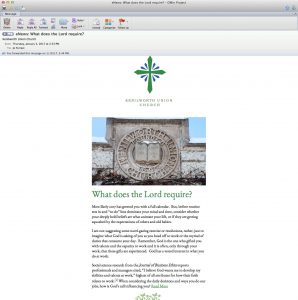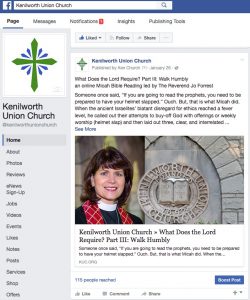After 20+ years in corporate management and consulting, working in a wide variety of financial institutions throughout the US, it became clear that professionals were often expected to “check their faith at the door” as they entered the workplace, myself included. Economist Milton Friedman’s iconic 1970 New York Times article is frequently cited when defending this practice. According to Milton, business leaders have “one and only one” responsibility, which is to increase profits, and never let their perceived “social responsibilities” infringe on their decisions. [1]
My own experience of wondering how my faith could guide my work fuels a fundamental aspect of my call to ministry: to serve – and challenge – the lost and least, who are articulate, educated, but starving for meaning in their professional life. My sense of call and practical experience in ministry drove this project to understand the ways clergy can minister to professionals in the workplace.
Do, Walk & Love: Design Overview
Proprietary research and academic studies confirm that a majority of clergy admit they will sidestep conversations about work, sensing their own inability to engage in conversations about the workplace. Not surprisingly, at the same time church members perceive their career and workplace concerns are outside the mission of their church. This avoidance by both clergy and members creates and maintains a “gap” between faith and work and drives members to seek support elsewhere or avoid conversations with clergy.[2]
Compounding the perceived gap, clergy preach and teach with the traditional language of the church and academy. For many clergy, even though it may occur to them that these words and ideas are foreign, they may also think they entice listeners to the realm of church. Instead they alienate them.
If individuals become accustomed to thinking their work challenges are isolated from their faith and faith community, in times of crisis they may neglect to rely upon their core beliefs, feel disenfranchised from their church, or avoid developing relationships with other business leaders based upon a common faith in God. Worse yet, individuals may disengage from their faith communities entirely, thinking church has little relevance in their lives. And this lack of “relevance” is a key factor is the continual decline in church attendance.[3]
Recognizing this divide between faith and work, when I was called to serve at Kenilworth Union Church, a non-denominational church in the Chicago metro area with a member base of over 1,500, we began a Faith & Leadership (F&L) program in 2014. The F&L committee hosts events in which leaders, recognized within the community for achieving career success, are invited to speak before an audience of congregational and community members. Speakers have addressed wide-ranging topics of their faith journey, challenges in which their Christian beliefs influenced decisions, and often describe practices to sustain their faith.
However popular these events have become, participants want “more” content yet not through in-person events. When pressed, they describe “more” may include case studies, scripture reflections, testimonies or devotions and preferably delivered in an electronic format. We imagined video blogs (vlogs), podcasts, online discussion groups, and much more, but decided to test the waters with simple blog posts.
This project sought to confirm my personal experience and the anecdotal comments of church members through peer-reviewed research among practical theologians, social scientists, and theologians of the perceived divide between faith and work. The findings from the varying disciplines shaped the content and approach, along with a cultural studies approach for teaching and interpreting, for a blog series on Micah 6:8.
Common Threads Emerge in Research
When asked by practical theologians, professionals easily recall facing ethical challenges in their work lives, yet an overwhelming majority reported that the church had done little or nothing to equip them for faithful living at work.[4] In a parallel vein, research among corporations revealed a desire to separate spiritual matters from workplace concerns from a desire to avoid any risk of potential risk or litigation.[5]
A 2008 Journal of Management Inquiry article aptly titled “(Dis)Missing the Obvious: Will mainstream management research ever take religion seriously?” noted the lack of attention by social scientists to the role of faith in the lives of business workers. This research shaped a movement to critically examine the role of religion – not just spirituality – to understand faith’s influence and the connections between faith and work that are valued by individuals.[6]
Just a year later a group of researchers developed and published a Faith and Work Scale (FWS), which defined the degree to which individuals are able to integrate their beliefs and practices with their work. This scale is based upon responses by professions to statements with a five-point scale in which 5=“Always” to 1=“Never” or “Infrequently.” Of the fifteen in the FWS, the top five are as follows: [7]
Faith and Work Scale
Practical theologians and social scientists were not the only disciplines to neglect faith and work. Theologian Miroslav Volf blames theologians and philosophers as far back as the Greeks for the perceived divide between faith and work, presenting as evidence “the number of pages written over the ages arguing about transubstantiation – whether it does or does not take place on Sunday – verses the thin number that explore the lives of members Monday through Saturday.”[8] Volf then developed a theology of work to promote an understanding that work is a viable setting for an individual to experience God’s grace and presence. His theology proposes an understanding that God has given particular talents to individuals and these gifts, for many, only blossom in the workplace. Therefore work becomes the venue for individuals to not only carry out their vocation but to feel God’s presence in their lives and participate in God’s ongoing creation.
Both the FWS and Volf’s theology point to faith as a source to equip individuals to endure difficult circumstances and do good things for others. For those individuals who are able to able to integrate faith and work, their satisfaction with life increases as compared with those who are unable to achieve such unity.[9]
Will they read it?
With the research findings in mind I developed a framework for a four-part blog series using a cultural studies interpretation of Micah 6:8 and Richard Osmer and Fernando Segovia’s scholarship in congregational teaching. Each week’s blog post was written with a different FWS dimension, an interpretation of a portion of Micah 6:8, and a story or example from business to support the intended teaching. For example, week two’s post was based upon the “just” dimension of the scale (“I view my work as part of God’s plan to care for the needs of people.”) as I delved into “do justice” from Micah 6:8, and included the story of a major insurance company’s decision to implement a private bus services for employees following a sexual assault on public transportation.
These blog posts were distributed through the church’s available electronic communications channels of e-news and Facebook and relied upon our current best practices in attracting readership. These distribution channels posted a photo and a few sentences to entice readers to click to the full story that resided on the website. Simple tracking tools indicate 26-100 readers viewed the entire blog post each week.
 Although this represents only a fraction of the church’s membership and readership of the e-news, the blogs engaged far more individuals than historically attended an in-person Bible class series. As a first step, the blog series confirms the appetite for “more” can be met through electronic delivery channels but only fuels further experimentation on delivery format and frequency. Most of all, it remains unknown if the FWS, Volf’s theology of work, and my ability to draft interpretations will be able to to bridge the “gap.”
Although this represents only a fraction of the church’s membership and readership of the e-news, the blogs engaged far more individuals than historically attended an in-person Bible class series. As a first step, the blog series confirms the appetite for “more” can be met through electronic delivery channels but only fuels further experimentation on delivery format and frequency. Most of all, it remains unknown if the FWS, Volf’s theology of work, and my ability to draft interpretations will be able to to bridge the “gap.”
What’s next?
As the F&L committee at Kenilworth Union Church develops the 2017-2018 program calendar, we will need to consider the synergies of a companion blog, podcast, or vlog series, the use of online collaboration groups, and the use of other electronic channels with the live events. Since the launch of this project, additional resources have been introduced by organizations that may be licensed or leveraged, reducing the labor intense writing effort.
Through a steady stream of content, both in-person events and available on-demand, only then may we begin to query if the gap between faith and work is closing. In the meantime, the mere presence of these attempts I pray will connect with members in ways that open conversations about their work and God’s presence within their lives.
[1] Milton Friedman, “The Social Responsibility of Business is to Increase its Profits” The New York Times Magazine, September 13, 1970, accessed July 16, 2016, http://www.nytimes.com/1970/09/13/archives/a-friedman-doctrine-the-social-responsibility-of-business-is-to.html.
[2] John C. Knapp’s How the Church Fails Businesspeople (And What Can Be Done About It) (Grand Rapids, MI: William B. Eerdmans, 2012), xii.
[3] Michael Lipka, “What Surveys say about worship attendance – and why some stay home,” Pew Research Center September 13, 2103, accessed July 15, 2016, http://www.pewresearch.org/fact-tank/2013/09/13/what-surveys-say-about-worship-attendance-and-why-some-stay-home/.
[4] Knapp, How the Church Fails Business People, xi.
[5] Ian I. Mitroff and Elizabeth A. Denton, A Spiritual Audit of Corporate America: A Hard Look at Spirituality, Religion and Values in the Workplace (San Francisco: Jossey-Bass, 1999) 5.
[6] James E. King, “(Dis)Missing the obvious: Will mainstream management research ever take religion seriously?,” Journal of Management Inquiry, no. 17 (2008): 228, accessed July 15, 2016, Business Source Complete, EBSCOhost.
[7] Monty L. Lynn, Michael Naughton, and Steve VanderVeen, “Faith at Work Scale (FWS): Justification, Development, and Validation of a Measure of Judaeo-Christian Religion in the Workplace,” Journal Of Business Ethics 85, no. 2 (March 15, 2009): 227-243, accessed July 15, 2016, Business Source Complete EBSCOhost.
[8] Miroslav Volf, Work in the Spirit: Toward a Theology of Work (New York: Oxford University Press, 1991) 69.
[9] Alan G. Walker, “The Relationship between the Integration of Faith and Work with Life and Job Outcomes,” Journal of Business Ethics (Jan 2012), 459.
Save
Save



You’ve opened a dialogue that is relevant to everyone whether employed or not. Individual actions in any environment allow individuals to share personal core beliefs, but more directly reveal their faith while contributing to culture, environmental respect, and social implications for dealing with customers and employees. Nice work Jo! I look forward to reading more.